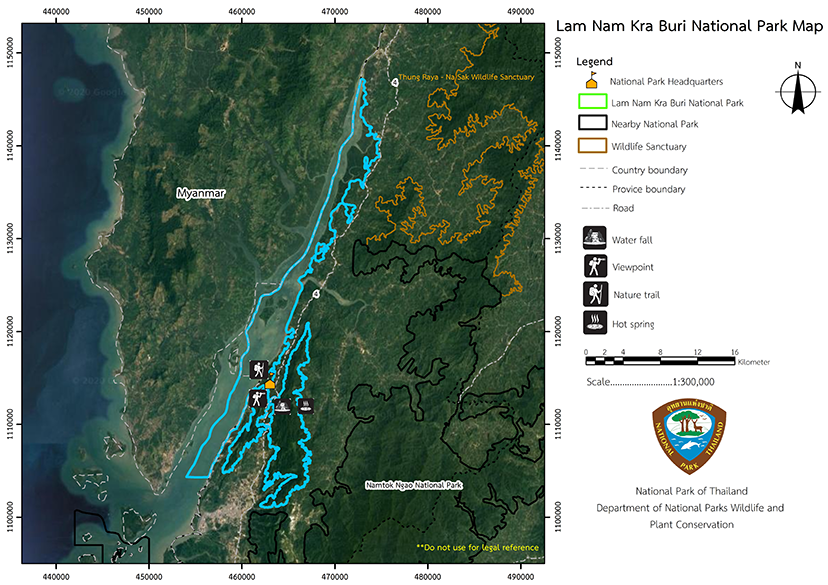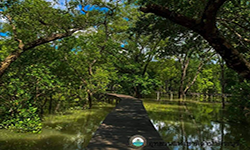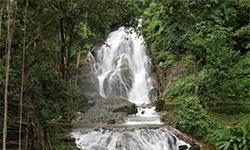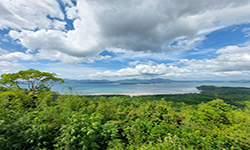Lam Nam Kra Buri National Park
Contact Location : Lam Nam Kraburi National Park, 130 Moo 3, Pak Nam Sub-District, Mueang District, Ranong Province, 85000
Telephone Number : (+66) 7 798 9817
Email : lumnamkraburiranong@gmail.com
Facebook : Lamnam Kra Buri National Park
Information
-
Background
Lam Nam Kraburi National Park is located on the Andaman Sea coast in Kraburi, La-un and Mueang District, Ranong Province. The National Park declaration was published in the Government Gazette, Volume 116, Part 29 Ko, dated April 21, 1999, with the area of 160 square kilometers. The Kranuri River is the border between the Union of Myanmar and Thailand west of the National Park, covering approximately 64 square kilometers, or 40%. The river is home to six islands, namely Ko Siat, Ko Khwang, Ko Chon, Ko Yao, Ko Pling, and Ko Nok Pela.
Note : After paying the entrance fee to the National Park, please carry the receipt for inspection.

100,000 rai (160 square kilometers)
|
|
|
|
|
|
|
|
Nature trails ⇔ Visit Waterfall ⇔ Observe flowers/plant ⇔ Bird/Butterfly ⇔ Mineral water bathing ⇔ Camping
Welfare shop : not available.
National Park Headquarters: AIS, TRUE, DTAC
|
|
Lam Nam Kraburi National Park covers 160 square kilometers or 100,000 rai, which can be classified as follows: The Kraburi River is the border between Thailand and the Union of Myanmar, about 40,000 rai (64 square kilometers) or 40% of the Lam Nam Kraburi National Park area. The water source originates near Phuket Mountain range and flows west through Kraburi District, Ranong Province, then to the south of La-un District, where it enters the Andaman Sea at the Kraburi River estuary, Mueang District, Ranong Province. The river is a total distance of about 60 kilometers in length and 6 kilometers in width. 1.2 The mangrove swamp forest exists on the banks of the Kraburi River and on the islands in it. The islands include Ko Khwang, Ko Yao, Ko Pling, Ko Chon, Ko Siat, and Ko Nok Pela, and they covering approximately 15,000 rai (24 square kilometers). 1.3The tropical rain forest area includes three national reserved forests, which reside in Kraburi, La-un and Mueang District, Ranong Province and have a total area of 45,000 rai (72 square kilometers). These are the Khlong Lam Liang– La-un National Reserved Forest, Khlong Set Kuat - Khao Hin Chang - Khao Sam Laem National Reserved Forest and La-un-Rattakrut National Reserved Forest. Border Territories North: Kraburi District, Ranong Province South: Mueang District, Ranong Province East: La-un District, Ranong Province West: The Union of Myanmar |
|
Lam Nam Kraburi National Park is located on the west coast of the southern region of Thailand, which is influenced by the monsoons. The southwest monsoon causes abundant rainfall, and in winter, the northeast monsoon brings slightly less rain and slightly cooler temperatures. Temperature Its location on a peninsula that extends out into the sea receives strong monsoon winds from both the southwest monsoon from the Indian Ocean and the northeast monsoon from the South China Sea and the Gulf of Thailand, causing humidity. The average temperature is not very high, and it is not too hot in the summer, but it is warmer during the rainy season and sometimes slightly cold in winter. The average annual temperature is about 27.6 degrees Celsius. The yearly average maximum temperature is 34.8 degrees Celsius. The annual lowest average temperature is 22.5 degrees Celsius. April is the hottest month (39.6 degree Celsius on 31 March 1983 and 19 April 1973). The lowest temperature measured was 13.7 degrees Celsius. April is the hottest month, and home to the highest temperatures in the park’s history. It reached 39.6 degrees Celsius on March 31, 1983, and April 19, 1973.
The monsoons significantly affects the relative humidity and air mass. Ranong Province has high relative humidity because of the monsoon winds arriving across the seas and oceans, which will bring vapor and humidity to the land. The annual relative humidity level of Ranong Province is 79.2%. The seasons in Ranong Province can be divided into three seasons: - Summer runs from mid-February to mid-May, when there is hot weather, and the hottest month is April. However, the heat is lower than other areas in Thailand because the sea cools the peninsula. - The rainy season runs from mid-May to mid-October when frequent low-pressure areas cause abundant rain. August has the most rainfall in the year. - Winter runs from mid-October to February when the colder and drier northeast monsoon winds from China prevail over Thailand. These cause a slight drop in temperature though it is not very cold and there is still rainfall along the coast. |
|
|
|
The significant plant species found at Punyaban Waterfall is Podocarpus neriifolius, which is called the Phaya Mai. Lam Nam Kraburi National Park contains high biological characteristics and forest conditions that can be classified as follows: Tropical Rain Forest: The tropical rain forest has annual rainfall of more than 2,000 millimeters and long periods. As a result, the forest has high growth, and adense canopy layer. The fertile tropical rain forest appears in the Khlong Set Kuat – Khao Hin Chang – Khao Sam Laem National Reserved Forest, and La Un – Ratchakrut National Reserved Forest in Lam Nam Kraburi National Park. The tropical rain forest is essential to the natural ecosystem and people's livelihood because it is a significant catchment area. The dominant trees are the Dipterocapaceae, such as Yang Yung (Dipterocapus grandiflorus), Yang Pai (D.costatus), Krabak (Fnisopters costa), Takhian Sai (Hopes pierrei), Takhian Sam Porn (Shores rogersiana), Ngok Kang (Parishia insigmis), Taco (Daracontomelum mangiferum). Other species of plants found in the tropical rain forest consist of the Persimmon Family (Ebennaceae), such as Nean (Diospyros wallichii), Euphorbiaceae Families such as Po Bai (Sapium baccatum), Dee Mee (Cleidion javanicum), and the Sapotaceae Family, such as Bird Jackfruit (Palaguium obovatum). The typical lower ground plants are from the ginger-galangal family (Zingiberaceae), which consists of Pood (Globba spp.), Kratue (Zingiber spp.), plants in the Boesenbergia Order, and Wild Rambutan (Kaempfceria pulchra). Plants in the Palmea family include rattan in the Calamus Order, Korthalsia, and Tao Rang (Garyota sp.). Mangrove Swamp Forest: Lam Nam Kraburi National Park contains complete mangrove swamp forests. The loamy soil characteristic of the Kraburi stream and the brackish water from the sea flood are appropriate for mangrove survival, and the forest exists in the Khlong La-un River and Kraburi stream estuaries, as well as beside Khao Hin Chang and on the islands. The plant species found are Small-Leaved Mangroves (Rhizophora apiculata), Large-Leaved Mangroves (R. mucronata), Black Beans (Briguiera pamviflora), Prong Daeng (Ceriops tagal), Phang Ka (Brnguiera spp.), the Avecenniaeae Family, including Samae (Avicennia spp.) and Tabun (Xylocarpus spp.). The ground species are Sea Holly (Acanthus ilicifolius), Fish Maw (Finlaysonia maritima), PengTalay (Phoenix paludosa), and Palm (Nypa sruticans). The secondary forest appears on invaded land or abandoned farms. The plant species commonly found on the detiorated soil are grass (Imperata cylindrica) and West Indian Lantana (Lantana aslvifolia). In the cleared areas, the replacement plants and pioneer species such as Mangtan (Schima wallichii), Po Hu (Hibiscus macrophyllus), San Yai (Dillenia obovata), Plau Noi (Croton delpyi), Som (Grypteronia paniculata) and Kho (Livistona speciosa) appear Wildlife Thailand is rich in wildlife species because of the complex topography in three geographic zones. It is located in the Indochina geography, which has typical grasslands and sparse forests along the plains or low altitudes, thus animals from this region are important to the grassland and sparse forest. The climate is monsoonal with different seasonal conditions. Lam Nam Kraburi National Park has various wildlife as the wild animals are diversed. It is also a waterhead area, food sources, and connected to other forests which is suitable for being a habitat and shelter for various animals. A detailed survey of wildlife species in the Lam Nam Kraburi National Park has not been completed but from local information, wildlife species can be categorized as follows: Mammals Survey result suggests that they are relatively diversed considering the area size. Species include: - Sunda Pangolin (Manis Javanica) is easily seen as they live in all kinds of forest - Insectivora : such as different types of rats, where information is still insufficient - Sunda flying lemur is found scattered in the tropical rain forest - Chiroptera : very diversed in all types of forest - The primates consist of Southern Pig-Tailed Macaques (Macaca nemesteing), which live in the tropical rain forests but not in large troops, and the Crab-Eating Macaque (Macaca fascicularis), which are commonly found in mangrove swamp forests in large groups. There are groups of Stump-Tailed Macaques (Macaca aretodes) and the Southern Spectacled Leaf Monkeys in the tropical rain forest withon high tree canopies, although these are rarer. They live in groups of about 10 to15. - Canivor tracks and paw prints indicate that the Sun Bear (Ursus malayanus), Smooth-Coated Otter (Viverra zibetha), Small Indian Civet (Viverricula indica), and Mongoose (Herpestes sp.) live or have lived in the park. - Even-toed ungulates consist of Wild Boar (Cus scrofa), Mouse Deer (Tragulus jaramicus), Wild Deer (Cervus unicolor), and Barking Deer (Muntiacus muntjac) and Fea's Muntjac (Muntiacus feac). The rangers often spotted them in the tropical rain forest near a water source, and Chamois and Koram migrate through the area from the Union of Myanmar. Rodents include Black Giant Squirrels (Ratufa bicolor), Grey-Bellied Squirrel, and the Red-Bellied Tree Squirrel Birds: There are more than 106 species (Table 2) in the various habitats that include forests, creeks, waterways, and plain areas. Moreover swamp forest, 18 Wreathed Hornbills, which had traveled from Myanmar, have been found in the National Park area looking for food in the daytime before roosting in Myanmar. |
How to get there by car :
At the milestone No. 595 of Highway No. 4, turn off towards the National Park entrance, and travel another 1 kilometer. The Lam Nam Kraburi National Park Headquarters is 18 kilometers from Mueang District, Ranong Province.
The east side of Lam Nam Kraburi National Park is adjacent to the Phetkasem Road (Highway No.4), for a distance of 1 kilometer, so it's easily accessed. For the south, from Ranong town, to the Ranong River estuary, passing through Chao Mueang Ranong cemetery.
Passenger boats are available to travel down the Kraburi River throughout the year.
Update soon
Lam Nam Kraburi National Park Headquarters
National Park Ranger Station Ko Bo No. 1 (Hat Yai)
National Park Ranger Station Ko Bo No. 2 (Dat Hin Ngam)
Accommodation : Kraburi 201-205 (Phaya Mai 01-05)
Lam Nam Kraburi National Park offers a relatively small number of lodges. The camping ground is available and tents and equipment can be rented. Food and restaurants are available.




